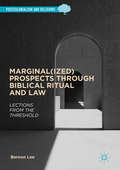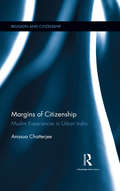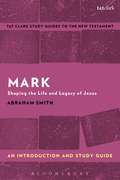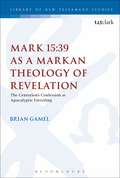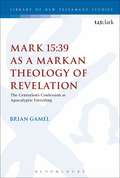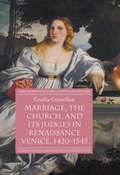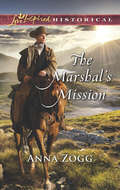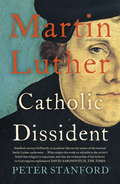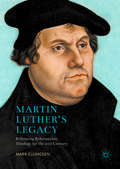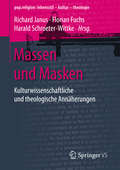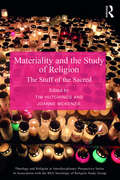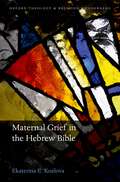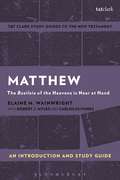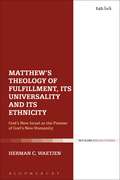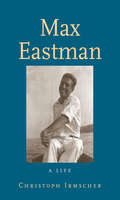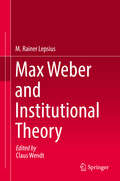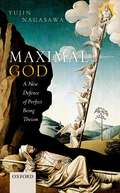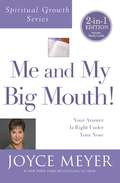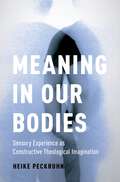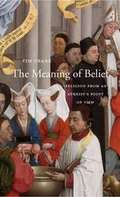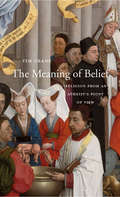- Table View
- List View
Marginal(ized) Prospects through Biblical Ritual and Law: Lections from the Threshold
by Bernon LeeThis book follows a reader’s logic of association through a series of overlapping constructs in biblical prescription of things prized and lofty—holy hair, unblemished beasts, sacred edibles, wholesome wombs, pristine precincts, esteemed ethnicities and, as unlikely as it seems, dismembered members. Thoroughly intersectional in disposition, Bernon Lee uncovers not just the precariousness of the contrived dichotomies through the identity-building sacred texts, but also the complexities and contentions of a would-be decolonizing hermeneutic bristling with its own tensions and temptations. This volume is an intertextual odyssey through law and ritual from impassioned positions fraught with ambivalence, reticence, and anxiety.
Margins of Citizenship: Muslim Experiences in Urban India (Religion and Citizenship)
by Anasua ChatterjeePart of the ‘Religion and Citizenship’ series, this book is an ethnographic study of marginality of Muslims in urban India. It explores the realities and consequences of socio-spatial segregation faced by Muslim communities and the various ways in which they negotiate it in the course of their everyday lives. By narrating lived experiences of ordinary Muslims, the author attempts to construct their identities as citizens and subjects. What emerges is a highly variegated picture of a group (otherwise viewed as monolithic) that resides in very close quarters, more as a result of compulsion than choice, despite wide differences across language, ethnicity, sect and social class. The book also looks into the potential outcomes that socio-spatial segregation spelt on communal lines hold for the future of the urban landscape in South Asia. Rich in ethnographic data and accessible in its approach, this book will be useful for scholars and researchers of sociology, social anthropology, human geography, political sociology, urban studies, and political science.
Margins of Citizenship: Muslim Experiences in Urban India (Religion and Citizenship)
by Anasua ChatterjeePart of the ‘Religion and Citizenship’ series, this book is an ethnographic study of marginality of Muslims in urban India. It explores the realities and consequences of socio-spatial segregation faced by Muslim communities and the various ways in which they negotiate it in the course of their everyday lives. By narrating lived experiences of ordinary Muslims, the author attempts to construct their identities as citizens and subjects. What emerges is a highly variegated picture of a group (otherwise viewed as monolithic) that resides in very close quarters, more as a result of compulsion than choice, despite wide differences across language, ethnicity, sect and social class. The book also looks into the potential outcomes that socio-spatial segregation spelt on communal lines hold for the future of the urban landscape in South Asia. Rich in ethnographic data and accessible in its approach, this book will be useful for scholars and researchers of sociology, social anthropology, human geography, political sociology, urban studies, and political science.
Mark: Shaping the Life and Legacy of Jesus (T&T Clark’s Study Guides to the New Testament)
by Abraham SmithThis Guide reads the Gospel of Mark as a 1st-century CE story about Jesus, for his followers, and against tyranny or the abusive use of power. First, the book shows students how the Gospel uses the form of a traditional laudatory biography (a 'Life') to reshape the memory of the shame-ridden trials and suffering of Jesus. Such a biography portrayed Jesus' descent (as a son of God), his deeds, and his heroic death, dispelling any notion that the teacher Jesus was a charlatan or huckster. Second, Smith demonstrates how the Gospel devotes a great deal of space to Jesus' training of his disciples - as he calls, commissions, and corrects them in preparation for the difficult moments of their journey.Third, Smith highlights the Gospel's special characterizations of Jesus - as a prophetic envoy, a man of authority, and a philosophical hero - contrasting Jesus' use of power with the abusive use of power by Rome's representatives (Herod Antipas and Pilate).
Mark 15: The Centurion's Confession as Apocalyptic Unveiling (The Library of New Testament Studies #574)
by Brian K. GamelIn the Gospel of Mark, Jesus' arrest, trial and execution ends with the Roman centurion who oversees the death process proclaiming Jesus as God's son. Gamel explores two key questions in relation to this moment: what does the centurion mean when he says that Jesus is God's son, and why does he say it? The confession is not made on the basis of any signs nor from any indication that he perceives Jesus' death as honourable or exemplary. This apparent lack of motivation itself highlights a key Markan theme: that this insight is revealed by an apocalyptic act of God, signalled by the tearing of the temple veil. Thus the confession, which we can understand to be made sincerely and knowledgeably, is the result of an act of God's revelation alone. Gamel explores the theory of Mark depicting a story in which all human characters exhibit varying levels of blindness to the spiritual realities that govern their lives. By making a thorough examination of Mark's Gospel – while placing primary focus on the centurion, the study is unlimited and presents a serious examination of the whole Gospel – Gamel concludes his argument with the point that, at the foot of the cross, this blindness is decisively confronted by God's apocalyptic act. The offer of sight to the centurion demonstrates the reconciliation of God and humanity which are otherwise in Mark's Gospel repeatedly presented as antagonistic spheres. Finally, the fact that revelation is offered to a Gentile highlights the inclusion of the nations into the promises of Israel.
Mark 15: The Centurion's Confession as Apocalyptic Unveiling (The Library of New Testament Studies)
by Brian K. GamelIn the Gospel of Mark, Jesus' arrest, trial and execution ends with the Roman centurion who oversees the death process proclaiming Jesus as God's son. Gamel explores two key questions in relation to this moment: what does the centurion mean when he says that Jesus is God's son, and why does he say it? The confession is not made on the basis of any signs nor from any indication that he perceives Jesus' death as honourable or exemplary. This apparent lack of motivation itself highlights a key Markan theme: that this insight is revealed by an apocalyptic act of God, signalled by the tearing of the temple veil. Thus the confession, which we can understand to be made sincerely and knowledgeably, is the result of an act of God's revelation alone. Gamel explores the theory of Mark depicting a story in which all human characters exhibit varying levels of blindness to the spiritual realities that govern their lives. By making a thorough examination of Mark's Gospel – while placing primary focus on the centurion, the study is unlimited and presents a serious examination of the whole Gospel – Gamel concludes his argument with the point that, at the foot of the cross, this blindness is decisively confronted by God's apocalyptic act. The offer of sight to the centurion demonstrates the reconciliation of God and humanity which are otherwise in Mark's Gospel repeatedly presented as antagonistic spheres. Finally, the fact that revelation is offered to a Gentile highlights the inclusion of the nations into the promises of Israel.
Marriage, the Church, and its Judges in Renaissance Venice, 1420-1545
by Cecilia CristellonThis book investigates the actions of marriage tribunals by analyzing the richest source of marriage suits extant in Italy, those of the Venetian ecclesiastical tribunal, between 1420 and the opening of the Council of Trent. It offers a strongly representative overview of the changes the Council introduced to centuries-old marriage practices, relegating it to the realm of marginality and deviance and nearly erasing the memory of it altogether. From the eleventh century onward, the Church assured itself of a jurisdictional monopoly over the matter of marriage, operating both in concert and in conflict with secular authorities by virtue of marriage’s civil consequences, the first of which regarded the legitimacy of children. Secular tribunals were responsible for patrimonial matters between spouses, though the Church at times inserted itself into these matters either directly, by substituting itself for the secular authority, or indirectly, by influencing Rulings through their own sentences. Lay magistratures, for their part, somewhat eroded the authority of ecclesiastical tribunals by continuing to exercise autonomous jurisdiction over marriage, especially regarding separation and crimes strictly connected to the nuptial bond and its definition, including adultery, bigamy, and rape.
Marriage, the Church, and its Judges in Renaissance Venice, 1420-1545
by Cecilia CristellonThis book investigates the actions of marriage tribunals by analyzing the richest source of marriage suits extant in Italy, those of the Venetian ecclesiastical tribunal, between 1420 and the opening of the Council of Trent. It offers a strongly representative overview of the changes the Council introduced to centuries-old marriage practices, relegating it to the realm of marginality and deviance and nearly erasing the memory of it altogether. From the eleventh century onward, the Church assured itself of a jurisdictional monopoly over the matter of marriage, operating both in concert and in conflict with secular authorities by virtue of marriage’s civil consequences, the first of which regarded the legitimacy of children. Secular tribunals were responsible for patrimonial matters between spouses, though the Church at times inserted itself into these matters either directly, by substituting itself for the secular authority, or indirectly, by influencing Rulings through their own sentences. Lay magistratures, for their part, somewhat eroded the authority of ecclesiastical tribunals by continuing to exercise autonomous jurisdiction over marriage, especially regarding separation and crimes strictly connected to the nuptial bond and its definition, including adultery, bigamy, and rape.
The Marshal's Mission: The Nanny's Temporary Triplets Her Cherokee Groom An Unlikely Mother The Marshal's Mission (Mills And Boon Love Inspired Historical Ser.)
by Anna ZoggLawman with a Secret
Martin Luther: Catholic Dissident
by Peter Stanford'A compelling biography of one of the greatest men of the modern age. Stanford is particularly brilliant on the tensions inside Luther's private and spiritual life. This is a very fine book, written with a flourish.' Melvyn BraggThe 31st of October 2017 marks the 500th anniversary of Martin Luther pinning his 95 'Theses' - or reform proposals - to the door of his local university church in Wittenberg. Most scholars now agree that the details of this eye-catching gesture are more legend than hammer and nails, but what is certainly true is that on this day (probably in a letter to his local Archbishop in Mainz), the Augustinian Friar and theologian issued an outspokenly blunt challenge to his own Catholic Church to reform itself from within - especially over the sale of 'indulgences' - which ultimately precipitated a huge religious and political upheaval right across Europe and divided mainstream Christianity ever after.A new, popular biography from journalist Peter Stanford, looking at Martin Luther from within his Catholic context, examining his actual aims for Catholicism as well as his enduring legacy - and where he might fit within the church today. 'Peter Stanford makes the life of Luther into a thrilling narrative, told from a modern Catholic perspective' Antonia Fraser
Martin Luther's Legacy: Reforming Reformation Theology for the 21st Century (PDF)
by Mark EllingsenThis volume is a unique interpretation of what Martin Luther contributes to renewed appreciation of Biblical diversity. The Church in the West is struggling. One reason behind this is that the prevailing models for Theology have imposed logical and modern ways of thinking about faith that renders theology academic, and therefore largely irrelevant for daily life. By letting the first Reformer speak for himself in this book, Mark Ellingsen shows how Martin Luther’s theological approach can reform the Church’s theology today. The real Luther-not the one taught by his various systematic interpreters-presents Christian faith in its entirety, with all its rough edges, in such a way as to direct on how and when to employ those dimensions of the Biblical witness most appropriate for the situation in which we find ourselves.
Massen und Masken: Kulturwissenschaftliche und theologische Annäherungen (pop.religion: lebensstil – kultur – theologie)
by Richard Janus Florian Fuchs Harald Schroeter-WittkeUnter dem Stichwort Massen und Masken werden zwei Phänomene aus kulturwissenschaftlicher und theologischer Perspektive beleuchtet, die komplementär sind. Viele Bereiche des menschlichen Lebens werden von Massenkultur geprägt. Zu einer entsprechenden Eventkultur gehören die vielen Festivals, aber auch der Kirchentag. Massenevents werden in Szene gesetzt und medial verbreitet. Mit Blick auf die Massenveranstaltungen des Nationalsozialismus erweisen sie sich als ambivalent. Das Subjekt ist nicht nur Individuum, sondern auch Teil einer größeren Menge, die es ihm ermöglicht, Erfahrungen von Ekstase zu machen. Karneval ist eine bestimmte Form der heutigen Massenkultur, die ihre eigenen Traditionen mit sich trägt. Karneval inszeniert sich selbst und die Menschen, die daran teilnehmen. Die Verkleidung, die Musik, die Umzüge spielen eine Rolle. Zugleich fordert der Karneval mit seinem überschießenden Charakter heraus. Grenzverletzungen gehören stets dazu und finden in der Verletzung religiöser Gefühle einen neuralgischen Punkt. Aber auch vestimäre und philosophische Fragestellungen bleiben nicht aus.
Materiality and the Study of Religion: The Stuff of the Sacred (Theology and Religion in Interdisciplinary Perspective Series in Association with the BSA Sociology of Religion Study Group)
by Tim Hutchings Joanne McKenzieMaterial culture has emerged in recent decades as a significant theoretical concern for the study of religion. This book contributes to and evaluates this material turn, presenting thirteen chapters of new empirical research and theoretical reflection from some of the leading international scholars of material religion. Following a model for material analysis proposed in the first chapter by David Morgan, the contributors trace the life cycle of religious materiality through three phases: the production of religious objects, their classification as religious (or non-religious), and their circulation and use in material culture. The chapters in this volume consider how objects become and cease to be sacred, how materiality can be used to contest access to public space and resources, and how religion is embodied and performed by individuals in their everyday lives. Contributors discuss the significance of the materiality of religion across different religious traditions and diverse geographical regions, paying close attention to gender, age, ethnicity, memory and politics. The volume closes with an afterword by Manuel Vásquez.
Materiality and the Study of Religion: The Stuff of the Sacred (Theology and Religion in Interdisciplinary Perspective Series in Association with the BSA Sociology of Religion Study Group)
by Tim Hutchings Joanne McKenzieMaterial culture has emerged in recent decades as a significant theoretical concern for the study of religion. This book contributes to and evaluates this material turn, presenting thirteen chapters of new empirical research and theoretical reflection from some of the leading international scholars of material religion. Following a model for material analysis proposed in the first chapter by David Morgan, the contributors trace the life cycle of religious materiality through three phases: the production of religious objects, their classification as religious (or non-religious), and their circulation and use in material culture. The chapters in this volume consider how objects become and cease to be sacred, how materiality can be used to contest access to public space and resources, and how religion is embodied and performed by individuals in their everyday lives. Contributors discuss the significance of the materiality of religion across different religious traditions and diverse geographical regions, paying close attention to gender, age, ethnicity, memory and politics. The volume closes with an afterword by Manuel Vásquez.
Maternal Grief in the Hebrew Bible (Oxford Theology and Religion Monographs)
by Ekaterina E. KozlovaSetting out from the observation made in the social sciences that maternal grief can at times be a motor of societal change, Ekaterina E. Kozlova demonstrates that a similar mechanism operates also in the biblical world. Kozlova argues that maternal grief is treated as a model or archetype of grief in biblical and Ancient Near Eastern literature. The work considers three narratives and one poem that illustrate the transformative power of maternal grief in the biblical presentation: Gen 21, Hagar and Ishmael in the desert; 2 Sam 21: 1-14, Rizpah versus King David; 2 Sam 14, the speech of the Tekoite woman; Jer 31: 15-22, Rachel weeping for her children. Although only one of the texts literally refers to a bereaved mother (2 Sam 21 on Rizpah), all four passages draw on the motif of maternal grief, and all four stage some form of societal transformation.
Matthew: The Basileia of the Heavens is Near at Hand (T&T Clark’s Study Guides to the New Testament)
by Elaine M. WainwrightRecent decades have seen significant shifts in biblical scholarship opening up a range of ways of engaging the biblical narrative - both methodologically (the tools and techniques for engaging the text) and hermeneutically (the perspectives that inform an interpreter's approach to the text and to the interpretative task). It is these shifts that give shape to this introduction and study guide, so that students encounter not only the text of Matthew itself but also its rich lode of recent interpretation. Among aspects of 1st-century life brought to the fore by current social-scientific methodology are kinship, the honor and shame culture, and masculinity. Gender is another interpretative lens that has characterized the study of the Gospel of Matthew in recent decades and the Guide provides pathways through this rich literature. The guide to Matthew concludes with the most recent turn of the hermeneutical lens, namely an ecological perspective on what is perhaps the best-known text in Matthew, the Beatitudes. This final chapter is an example of how we can enter an old and familiar text like the Gospel of Matthew from yet another new critical direction.
Matthew's Theology of Fulfillment, Its Universality and Its Ethnicity: God’s New Israel as the Pioneer of God’s New Humanity
by Herman C. WaetjenThe interpretation of this gospel integrates an objective analysis of its historical context and a subjective semantic disclosure of meaning. To that end, a close reading of the text is combined with consistency building in order to achieve textual congruence and plenitude of meaning. The subject/ object split of traditional biblical scholarship that requires analysis in order to produce explanation as a definable object is superseded in this book by the event of reading as a dynamic happening of personal experience from which the reader cannot detach herself or himself.
Matthew's Theology of Fulfillment, Its Universality and Its Ethnicity: God’s New Israel as the Pioneer of God’s New Humanity
by Dr Herman C. WaetjenThe interpretation of this gospel integrates an objective analysis of its historical context and a subjective semantic disclosure of meaning. To that end, a close reading of the text is combined with consistency building in order to achieve textual congruence and plenitude of meaning. The subject/ object split of traditional biblical scholarship that requires analysis in order to produce explanation as a definable object is superseded in this book by the event of reading as a dynamic happening of personal experience from which the reader cannot detach herself or himself.
Max Eastman: A Life
by Christoph IrmscherThe definitive biography of a radical activist and intellectual Max Eastman (1883–1969) was a prolific writer, radical, and public intellectual who helped shape the twentieth century. While researching this masterful work, acclaimed biographer Christoph Irmscher was granted unprecedented access to the Eastman family archive, allowing him to document little-known aspects of the famously handsome and charismatic radical. Considered one of the “hottest radicals” of his time, Eastman edited two of the most important modernist magazines, The Masses and The Liberator, and campaigned for women’s suffrage and world peace. A fierce critic of Joseph Stalin, Eastman befriended and translated Leon Trotsky and remained unafraid to express unpopular views, drawing criticism from both conservatives and the Left. Set against the backdrop of several decades of political and ideological turmoil, and interweaving Eastman’s singular life with stories of the fascinating people he knew and loved, this book will have broad interdisciplinary appeal in twentieth-century history and politics, intellectual history, and literary studies.
Max Weber and Institutional Theory
by M. Rainer Lepsius Claus WendtThis book presents a collection of essays on institutional theory written by the German sociologist and Weber-expert M. Rainer Lepsius. Based on Weber’s work, the author develops concepts of institutional theory, which he subsequently applies to topics such as National Socialism, democratization processes, German unification, and the institutionalization of the European Union. By showing how charismatic leadership can under certain circumstances threaten democratic structures and curtail individual freedoms, and by analyzing the structural and cultural conditions under which people develop trust in political and social structures and ultimately come to support and comply with them, the author provides a sound analytical understanding of the development of democratic institutions and a democratic political culture. This collection of essays was edited, translated and commented on by Claus Wendt.
Maximal God: A New Defence of Perfect Being Theism
by Yujin NagasawaYujin Nagasawa presents a new, stronger version of perfect being theism, the conception of God as the greatest possible being. Although perfect being theism is the most common form of monotheism in the Judeo-Christian-Islamic tradition its truth has been disputed by philosophers and theologians for centuries. Nagasawa proposes a new, game-changing defence of perfect being theism by developing what he calls the 'maximal concept of God'. Perfect being theists typically maintain that God is an omniscient, omnipotent, and omnibenevolent being; according to Nagasawa, God should be understood rather as a being that has the maximal consistent set of knowledge, power, and benevolence. Nagasawa argues that once we accept the maximal concept we can establish perfect being theism on two grounds. First, we can refute nearly all existing arguments against perfect being theism simultaneously. Second, we can construct a novel, strengthened version of the modal ontological argument for perfect being theism. Nagasawa concludes that the maximal concept grants us a unified defence of perfect being theism that is highly effective and economical.
Me and My Big Mouth!: Your Answer Is Right Under Your Nose (Spiritual Growth Ser.)
by Joyce MeyerWish you could take control of the words you speak, instead of feeling like your mouth has a mind of its own? With God's help you can! This companion study guide to ME AND MY BIG MOUTH! takes you from, "Oh, no, I can't believe I just said that!" to learning God's language. This book will show you how to train your mouth to speak words that will help you accomplish all God wants for you in this life. Bestselling author Joyce Meyer emphasizes that speaking the Word of God must be coupled with living a life of complete obedience to the Word of God in order to see the full power of God flowing in your life. By applying the biblical truths outlined in this book, you will learn: The effect of your words in the natural realm How to speak God's language How to break the chains of the past How to cross over to victory Plus much more! Bring your mouth into agreement with God . . . and begin to walk in victory!
Meaning in Our Bodies: Sensory Experience as Constructive Theological Imagination (AAR Academy Series)
by Heike PeckruhnMovement, smell, vision, and other perceptual experiences are ways of thinking and orienting ourselves in the world and are increasingly recognized as important resources for theology. In Meaning in Our Bodies, Heike Peckruhn seeks to discover how embodied differences like gender, race, disability, and sexuality connect to perceptual experience and theological imagination. Peckruhn offers historical and cultural comparisons, showing how sensory experience can order normalcy, social status, and communal belonging. She argues that scholars who appeal to the importance of bodily experiences need to acquire a robust and nuanced understanding of how sensory perceptions and interactions are cultural and theological acts of making meaning. This is a critical volume for feminist theorists and theologians, critical race theorists, scholars of disability and embodiment, and liberation thinkers who take experiences seriously as sources for theologizing and religious analysis.
The Meaning of Belief: Religion from an Atheist’s Point of View
by Tim CraneCurrent debate about religion seems to be going nowhere. Atheists persist with their arguments, many plausible and some unanswerable, but they make no impact on believers. Defenders of religion find atheists equally unwilling to cede ground. Noting that religion is not what atheists think it is, Tim Crane offers a way out of this stalemate.
The Meaning of Belief: Religion from an Atheist’s Point of View
by Tim CraneCurrent debate about religion seems to be going nowhere. Atheists persist with their arguments, many plausible and some unanswerable, but they make no impact on believers. Defenders of religion find atheists equally unwilling to cede ground. Noting that religion is not what atheists think it is, Tim Crane offers a way out of this stalemate.
